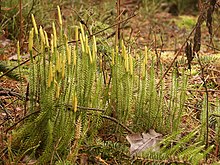Sprouting Bärlapp
| Sprouting Bärlapp | ||||||||||||
|---|---|---|---|---|---|---|---|---|---|---|---|---|

Moss snake ( Lycopodium annotinum ) |
||||||||||||
| Systematics | ||||||||||||
|
||||||||||||
| Scientific name | ||||||||||||
| Lycopodium annotinum | ||||||||||||
| L. |
The perennial, evergreen sprout bear moss ( Lycopodium annotinum ), also known as forest bear moss or snake bear moss , is a particularly protected representative of vascular spore plants according to the BArtSchV . In the past the plant was used as a magic or witch plant , as an aphrodisiac and was generally considered a medicinal plant . So it has an ethnobotanical meaning.
description
The sprout bear moss forms crawling rungs above ground that can be up to 1 m long. From these, about 10 to 30 cm tall, ascending shoots grow up, which can carry a densely leafed, directly seated sporophyll stand . The leaves of the ascending shoots resemble the coniferous leaves of conifers. They stand out horizontally, appear relatively rigid, sharply pointed and are finely serrated. However, there is no hair tip. The individual sporophyll stands sit directly on the leaf shoot and are about 2 to 4 cm long.
The sprouting Bärlapp forms visible sporophyll levels between August and September.
The number of chromosomes is 2n = 68.
Occurrence
The sprouting bear moss occurs in a circumpolar manner in the entire northern and southern hemisphere. It inhabits the temperate and boreal zones of the northern hemisphere in Europe, Asia and North America; especially in Europe, its distribution area extends from Norway to the Alps, the Apennines, the Carpathians and Croatia, it is also rarely found in the Pyrenees and in western France; in the southern part of England, in the central and northern part of Russia, it occurs sparsely; it is rarely found in Ireland or is absent there altogether. In the Alps it usually rises to an altitude of 2000 m, but occasionally also up to 2800 m. In the Allgäu Alps, it rises in the Tyrolean part of the Rohnenspitze near Zöblen up to 1970 m above sea level.
It occurs in damp, acidic, shady forests, especially in coniferous, bog and beech forests, and rarely in dwarf shrub heaths . He is a species of character of the order Piceetalia.
In Austria it is moderately common, in the German federal states it is seldom to very rare. In most federal states, it is classified as endangered or endangered on the red list of vascular plants because of its rarity. It is also particularly protected by the BArtSchV .
Taxonomy and systematics
To Lycopodium annotinum L. there are the following synonyms: Lycopodium dubium Zoëga , Lycopodium pungens Ilyin .
One can distinguish the following subspecies:
- Lycopodium annotinum L. subsp. annotinum
- Lycopodium annotinum subsp. alpestre (Hartm.) Á. Löve & D. Löve : It occurs in Iceland, Norway, Sweden, Finland, Russia and on the Faroe Islands .
literature
- Wolfgang Adler, Karl Oswald, Raimund Fischer: Excursion flora of Austria . Ed .: Manfred A. Fischer. Eugen Ulmer, Stuttgart / Vienna 1994, ISBN 3-8001-3461-6 .
Individual evidence
- ↑ a b Erich Oberdorfer : Plant-sociological excursion flora for Germany and neighboring areas . With the collaboration of Angelika Schwabe and Theo Müller. 8th, heavily revised and expanded edition. Eugen Ulmer, Stuttgart (Hohenheim) 2001, ISBN 3-8001-3131-5 , pp. 66 .
- ^ Oskar Sebald, Siegmund Seybold, Georg Philippi (ed.): The fern and flowering plants of Baden-Württemberg . 2nd, supplemented edition. tape 1 : General Part, Special Part (Pteridophyta, Spermatophyta): Lycopodiaceae to Plumbaginaceae . Eugen Ulmer, Stuttgart (Hohenheim) 1993, ISBN 3-8001-3322-9 .
- ↑ Erhard Dörr, Wolfgang Lippert : Flora of the Allgäu and its surroundings. Volume 1, IHW, Eching 2001, ISBN 3-930167-50-6 , p. 94.
- ↑ a b Christenhusz, M. & Raab-Straube, E. von (2013): Lycopodiophytina. - In: Euro + Med Plantbase - the information resource for Euro-Mediterranean plant diversity. Datasheet Lycopodium annotinum In: Euro + Med Plantbase - the information resource for Euro-Mediterranean plant diversity.
Web links
- Sprouting Bärlapp. In: FloraWeb.de.
- Sprouting Bärlapp . In: BiolFlor, the database of biological-ecological characteristics of the flora of Germany.
- Profile and distribution map for Bavaria . In: Botanical Information Hub of Bavaria .
- Lycopodium annotinum L. In: Info Flora , the national data and information center for Swiss flora .
- Distribution in the northern hemisphere from: Eric Hultén, Magnus Fries: Atlas of North European vascular plants. 1986, ISBN 3-87429-263-0 at Den virtuella floran. (swed.)
- Thomas Meyer: Bärlapp data sheet with identification key and photos at Flora-de: Flora von Deutschland (old name of the website: Flowers in Swabia )




